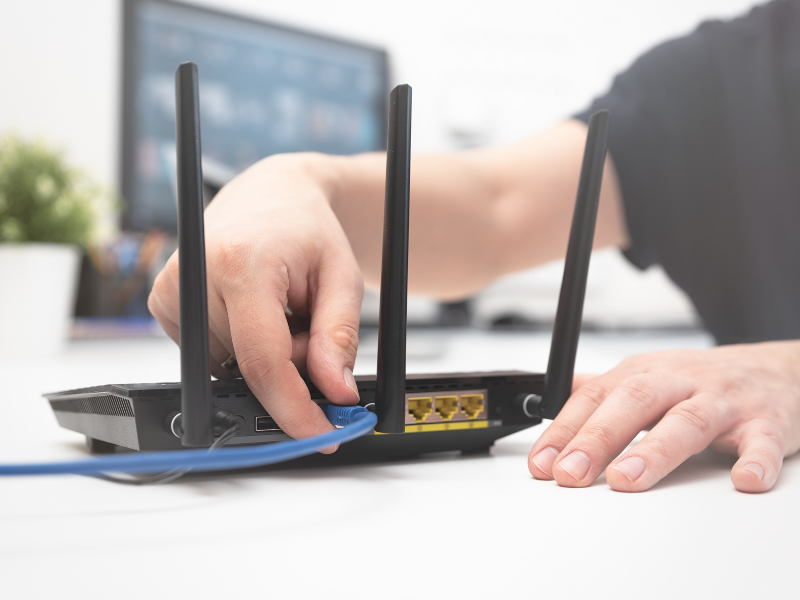
Avoid the ‘Wi-Fi gap’ and get the internet you need
4-minute read
With our home internet needs continuing to grow, there are some simple steps you can take to help ensure your home Wi-Fi is performing at its best.
If your home is anything like mine, the availability of high-speed Wi-Fi throughout the house is a concern that ranks not far behind electricity and hot showers.
This isn’t surprising though, given how digital our lives have become. For many Australians, the term ‘Wi-Fi’ is now interchangeable with ‘internet’. It’s such a convenient and efficient way to access the internet that it's become near ubiquitous in our homes.
Given how much we rely on internet in our day-to-day lives, it’s worth thinking about how well your home internet setup and internet plan (such as a plan over the nbn® network) are working to make sure you get the great experience you need and expect.

Falling into the 'Wi-Fi gap'
If the Wi-Fi you’re getting is slower than you think it should be, you might be falling into the ‘Wi-Fi gap’.
Signs of this may include streaming services buffering or freezing, blurry video or dropouts on video calls while you’re working from home, and problems arising when too many people are trying to use the Wi-Fi at once.
So, how does this Wi-Fi gap occur? It may be due to the speed and capacity of the internet service coming into your home. Alternatively, it might be down to the Wi-Fi network that allows everyone to access the internet that’s being delivered.
The good news is there are simple things you can do to close the Wi-Fi gap and get the internet experience you want. Let’s look at the Wi-Fi side of things first.
Is your Wi-Fi router too old?
This is a very important question when it comes to the performance of your home internet. Using an old Wi-Fi router is a common cause of poor connectivity, even for people that have fast internet plans.
Old routers may seem like they’re working fine and capable of supporting your internet usage as you upgrade to faster internet speeds, but they use old tech that’s slower, less secure and more prone to interference.
Using an old Wi-Fi router with fast internet speeds is a bit like putting worn-out tyres on a race car: the high-performance potential is lost, and the overall experience is pretty poor.
Router technology is constantly evolving, so a good rule of thumb is to update your Wi-Fi router about as often as you update your mobile phone.
It’s also important to remember that keeping a Wi-Fi router up to date is you and/or your phone and internet provider’s responsibility, so it’s worth checking the age of your current Wi-Fi router. Chat to your provider if you have any questions about your Wi-Fi router’s compatibility with the speeds on your current nbn plan.

Why are new Wi-Fi routers better?
New routers boast big advantages over older units.1 Some of the most important include:
- Higher speeds thanks to the latest Wi-Fi standards
- Improved range through factors like improved antennas, more radio channels and clever technology like beamforming2
- More devices handled simultaneously
- Better security
- Better network management and optimisation options
- Better usage controls for kids and connected devices around the house
Other Wi-Fi issue causes
An outdated Wi-Fi router can be a common cause of problems, but it’s not the only reason your Wi-Fi experience can fall short of expectations.
Other common home Wi-Fi problems can include the placement of routers in your home, particularly if your home has a lot of solid walls or multiple levels.
You can use Wi-Fi mesh networks with multiple, interlinked Wi-Fi access points to help provide you with more coverage throughout your home.
Additional sources of Wi-Fi issues can include outdated connected devices like laptops, TVs and tablets that don’t support the latest Wi-Fi standards. This is important because newer models not only increase performance, they also help keep your devices more secure.
Is your internet plan keeping up?
If your home Wi-Fi network is up to date and well set up, the next question to ask is whether you’ve got the right internet speed/plan to suit your needs.
Many households have been using the same internet service for years, even as home data demands have exploded.
An average Australian household doubles its data use every three years, yet two-thirds of users on the nbn network haven’t changed their internet speed/plan in the past three years.3
Consider how many streaming services you had and how often you worked from home the last time you updated your plan. Then, compare that to now – how many internet-connected devices do you have?
The answer might surprise you, with the average Australian household expected to have 33 internet connected devices by 2026.4
Each new gadget is going to place extra demand on your internet service, so it might be time for an upgrade.
The way we’re using the internet at home is changing all the time. If you do invest in the latest gadgets, make sure you’ve got the nbn plan and a Wi-Fi setup that can deliver that speed throughout your house.
In short, don’t put old tyres on your internet race car!
TL: DR (Too long, didn’t read)
- Keep your Wi-Fi router up to date.
- Consider upgrading your router as often as your mobile phone.
- Check your internet plan – is it time for an upgrade?
- What’s your internet use like now versus last time you upgraded your plan?

